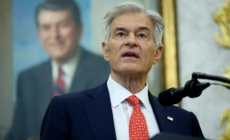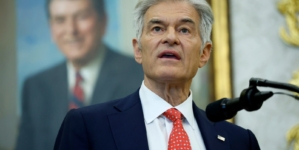-
Red Sox Lose 7-Year Veteran To Free Agency After Remarkably Short Stint - 5 mins ago
-
Trump’s Lust for Desecration - 14 mins ago
-
Airplane windscreen shatters mid-flight en route to Los Angeles - 36 mins ago
-
Medicare Update: Trump Official Dr. Oz Has New Advice for Recipients - 40 mins ago
-
Sean ‘Diddy’ Combs Will Appeal His Conviction and Prison Sentence - 58 mins ago
-
Texas A&M’s Mike Elko Addresses Penn State Rumors - about 1 hour ago
-
George Santos and President Trump’s Theory of Mercy - 2 hours ago
-
Eagles Announce Jalen Hurts Milestone After Vikings Game - 2 hours ago
-
Trump again suggests sending troops to San Francisco. Local officials call it chaos - 2 hours ago
-
Yankees Hall of Famer Calls Dodgers’ Shohei Ohtani MLB’s GOAT - 2 hours ago
H-1B visa holders handed major win by Supreme Court
The U.S. Supreme Court has declined to review a long-running challenge to a federal rule allowing certain spouses of H-1B visa holders to work in the United States, leaving intact a 2024 appellate decision that upheld the program’s legality.
Newsweek contacted immigration attorneys for comment via email outside of normal office hours on Wednesday.
Why It Matters
The Supreme Court’s decision to let stand a rule allowing certain spouses of H-1B visa holders to work in the United States preserves a key source of economic and family stability for thousands of immigrant households and the employers who rely on them.
By declining to hear a challenge from a group representing displaced U.S. tech workers, the justices effectively affirmed the government’s authority to grant work authorization to H-4 visa holders—a policy central to retaining high-skilled talent in a tightening labor market.
The outcome provides relief for families navigating long green-card backlogs and offers rare continuity in a politically charged area of immigration law that affects both the U.S. workforce and the country’s global competitiveness.

What To Know
In an order issued Monday, the justices denied a petition by Save Jobs USA, a group representing American technology workers who argued that the Department of Homeland Security (DHS) overstepped its authority when it extended work authorization to holders of H-4 visas—dependents of H-1B skilled workers.
The Court did not provide an explanation for its decision, consistent with its usual practice.
Nearly A Decade Of Legal Challenges Ends
The denial marks the end of nearly a decade of litigation that began after the Obama administration adopted the “Employment Authorization for Certain H-4 Dependent Spouses” rule in 2015.
The regulation permits spouses of H-1B workers who are pursuing permanent residency to obtain work authorization.
DHS estimated at the time that roughly 180,000 individuals would benefit in the first year and about 55,000 annually thereafter.
Save Jobs USA’s petition, filed in August 2024, asked the Court to determine whether DHS could “grant work authorization for classes of nonimmigrants for whom Congress has refused to grant work authorization.”
The group contended that the agency’s interpretation of immigration law “creates a separate immigration system that subverts the one Congress put in place.”
The D.C. Circuit Court of Appeals had previously rejected that argument, holding in Save Jobs USA v. U.S. Department of Homeland Security that federal law gave DHS authority to permit employment for nonimmigrants in limited circumstances.
The appeals court said that a related 2022 decision upholding a work-authorization program for foreign students “squarely forecloses” the challenge to the H-4 rule.
While the petitioners hoped the Supreme Court would revisit the issue following its 2024 ruling in Loper Bright Enterprises v. Raimondo—which eliminated the “Chevron deference” doctrine that had required courts to defer to reasonable agency interpretations—the justices left the D.C. Circuit’s decision in place.
Immigration attorneys said the outcome provides clarity for thousands of families navigating lengthy green-card backlogs.
A Win For Families, Debate For Policymakers
According to DHS data, more than 258,000 H-4 visa holders have received work authorization since the rule was enacted.
Advocates for immigrant professionals say that the ability of spouses—often highly educated themselves—to work helps retain skilled workers in the U.S. economy.
Austin Fragomen, the firm’s founding partner, told Forbes that allowing H-4 spouses to work “helps U.S. companies retain top global talent” and that limiting such rights “would push skilled families to competing economies. The last thing employers want is a new policy that makes it more challenging to hire or retain talent.”
Critics, however, maintain that the rule undermines job opportunities for American workers. John Miano, counsel for Save Jobs USA and an attorney with the Immigration Reform Law Institute, argued in the group’s filing that “the power to define which classes of aliens may work in the United States is vested in Congress, not the administrative state.”
Immigration Policy And Political Stakes Ahead
The Supreme Court’s decision comes at a time of heightened political debate over employment-based immigration.
On September 19, 2025, President Donald Trump proposed a $100,000 fee for new H-1B applications, while the Biden administration has defended existing visa categories as essential to U.S. competitiveness in technology and research sectors.
Under the H-1B program—created in 1990—U.S. companies can hire foreign professionals in specialty occupations for three to six years.
Employers must attest that they are paying prevailing wages and have first attempted to recruit American workers. The program is capped at 85,000 new visas annually.
For H-1B families, Monday’s decision represents a reprieve amid policy uncertainty. “The Supreme Court’s inaction leaves the status quo intact,” said Mehta. “It means that qualified spouses can continue working, businesses retain vital talent, and Congress still holds the power to legislate any changes it deems necessary.”
What People Are Saying
Cyrus D. Mehta, a New York-based immigration lawyer and adjunct professor at Brooklyn Law School, said: “Despite the evisceration of Chevron deference, courts need not rely on an agency’s interpretation of an INA provision in order to provide noncitizens with work authorization … because these statutory provisions are not ambiguous in the first instance.”
Jennifer Minear, President of the American Immigration Lawyers Association (AILA), said in a class-action filing: “The delays that H-4 and L-2 nonimmigrants are facing needlessly place families in financial limbo. DHS has the legal tools and authority to grant work authorization to impacted individuals whose financial security is hanging in the balance.”
Jesse Bless, Director of Federal Litigation at AILA, added: “The process to attain work authorization should not put families at risk of immense loss of income and instability. There are reasonable and immediate steps that DHS can take to make certain that visa holders meet requirements without imposing needless suffering.”
What Happens Next
With the Supreme Court declining to hear Save Jobs USA v. DHS, the D.C. Circuit’s ruling upholding work authorization for certain spouses of H-1B visa holders remains in place, effectively ending the legal challenge.
The decision secures continued employment rights for thousands of H-4 visa holders and brings short-term stability to skilled immigrant families and their employers. The Biden administration is expected to maintain the policy, though a future administration could attempt to roll it back through new rulemaking.
Legally, the outcome reinforces the Department of Homeland Security’s authority to grant limited work rights under existing visa programs, even as long-term uncertainty persists in the absence of congressional immigration reform.
Source link


















